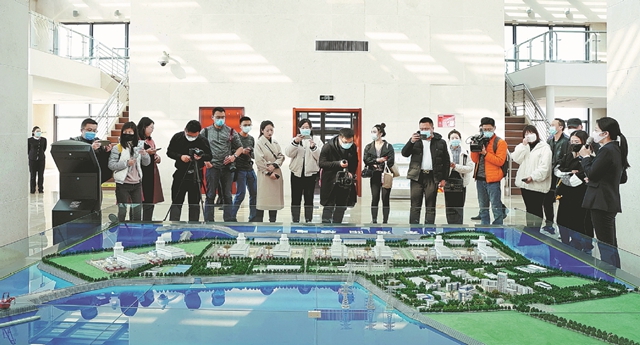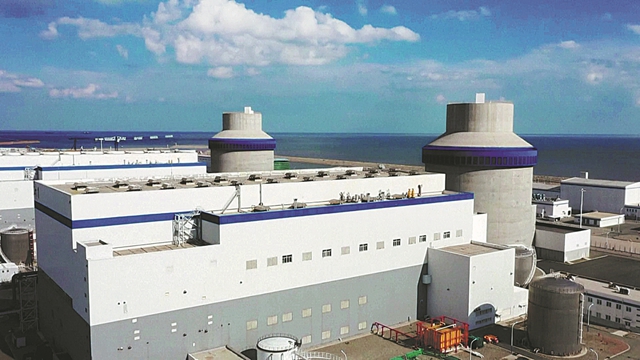Nuclear power brings Shandong carbon-free heat
By ZHENG XIN| (China Daily)| Updated : 2021-12-22
Print Print
Visitors check a scale model of the nuclear power plant in Haiyang, Shandong province. [Photo by NIE DONGLEI/FOR CHINA DAILY]
Green alternative replaces use of 12 local coal-fired water boilers
While heating costs in many cities in northern China have increased slightly this winter due to surging coal prices, Haiyang, Shandong province, has seen the opposite trend thanks to help from nuclear energy.
Residential buildings in Haiyang saw heating prices dip from 22 yuan ($3.45) per square meter to 21 yuan per square meter, as the city has started using heat generated from a nuclear power plant this winter. It thus became the first Chinese city to have carbon-free heating, said Zhang Jinfu, deputy mayor of Haiyang.
The nuclear energy heating project in East China's Shandong is able to provide winter warmth for 4.5 million square meters. This carbon-free alternative can replace the use of 12 local coal-fired water boilers and benefits 200,000 residents in Haiyang, and the move effectively increases heating efficiency while lowering costs, said its operator State Power Investment Corp.
The company launched a demonstration district heating system in Haiyang in November 2019, taking advantage of local nuclear energy facilities, and it has successfully provided nuclear heating services for some 700,000 square meters in the city.
The demonstration project is expected to further expand in Shandong province and benefit more local residents with clean heating that comes with ever-decreasing costs, the company said.
The Shandong government vows to achieve nuclear heating in all qualified regions on the Jiaodong Peninsula, Shandong, in the future, with the area on the peninsula enjoying such carbon-free heating expected to reach 200 million square meters by 2030, according to a plan released by State Power Investment Corp.
Luan Jian, head of Shandong's energy bureau, said the province will step up nuclear development on the peninsula during the 14th Five-Year-Plan period (2021-25) and actively push forward nuclear heating in the region.
The province also aims to have total nuclear installed capacity exceeding 13 million kilowatts by 2030, while focusing on building a 10-megawatt nuclear power base on the peninsula and actively promoting the use of nuclear energy for heating and other purposes.
According to SPIC, the nuclear heating project extracts nonradioactive steam from the secondary circuit of the two Haiyang AP1000 units, which is then fed through a multistage heat exchanger in an on-site heat exchange station.
The heat is then fed to an off-site heat exchange station belonging to a local thermal company, where heated water flows through municipal heating pipes to consumers.
Unit 1 and Unit 2 of the Haiyang Nuclear Power Plant in Shandong have produced more than 60 billion kilowatt-hours so far. Unit 1 of the plant is the world's largest cogeneration unit and has replaced 12 local coal-fired boilers, reducing the coal equivalent of 100,000 tons every heating season.
SPIC said the use of nuclear heating is expected to cut annual emissions of carbon dioxide by 180,000 tons, soot by 691 tons, sulfur dioxide by 1,188 tons and nitrogen oxide by 1,123 tons.
Analysts believe nuclear heating is an effective way to improve China's energy resource structure by utilizing nuclear energy for district heating, and to ease growing pressure on energy supplies.
Han Xiaoping, chief information officer at China Energy Net Consulting, said nuclear heating is an effective way to reduce emissions, as well as a key technological measure to combat pollution.

Heating facilities at a nuclear plant in Shandong province, providing heat for residential areas. [Photo/CHINA DAILY]
With the rapid development of China's nuclear energy sector, it is expected that many more regions in the country will bid farewell to coal-fired heating and welcome a cleaner way of warming up with cheaper costs and higher efficiency, he said.
China is capable of guaranteeing the secure utilization of nuclear heating with its mature technology, he added.
According to Liu Hua, an official with the International Atomic Energy Agency, the Haiyang project has improved thermal usage efficiency and the economy of nuclear power.
Liu said he expects strengthening technical cooperation with China in comprehensive utilization of nuclear energy, as well as more sharing of China's successful experience with the international community.
China has emerged as a top player on the global nuclear power generation stage, with an advanced nuclear power industry chain including uranium resources exploration, nuclear fuel supply, engineering design and development, engineering supervision, equipment manufacturing, operational maintenance and disposal of radioactive waste.
The country has always been promoting greener development and prioritizes safety and security of nuclear power plant construction. It has pledged to peak carbon emissions by 2030 and achieve carbon neutrality by 2060.
The country's nuclear energy industry has witnessed rapid development over the past three decades. By the end of August, China had 51 nuclear power units in operation, with an installed capacity of 53.26 million kW, industrial data showed.
Wei Hanyang, a power market analyst at research firm BloombergNEF, expects that more domestic technology will be adopted with installations likely nearing 100 gigawatts by the end of 2030, with surging power demand in the country, especially from coastal regions.
Most of the country's nuclear heating projects are based on large-scale nuclear units, while the country's major nuclear power companies are also working on small reactor heating solutions, which are currently under design or undergoing engineering trials.
China National Nuclear Corporation saw its heating demonstration project at the Qinshan Nuclear Power Plant in Zhejiang province enter operation on Dec 3, which uses the remaining thermal power from the Qinshan plant's units to provide safe, zero-carbon heating for residents and public facilities in Haiyan county.
The relevant nuclear heating technology is mature and has been widely used worldwide. Only heat exchange without any medium exchange will be generated during the whole heating process. Users will thus only be provided with fully safe heated water, the company said.
With clean-energy heating being a priority, the National Energy Administration released a five-year plan as early as 2017, highlighting the innovation of clean heating technology and consideration of nuclear heating.
After that, CNNC launched its independently researched and developed Yanlong reactor for district heating in November 2017, which it said is a safe, economical and green reactor product targeting heating demand in northern cities. The reactor, which can be operated at low temperatures and normal pressures, can be built near urban areas due to zero risk of a meltdown and lack of emissions, said the company.
It can be constructed either inland or in coastal areas, making it an especially good fit for northern inland areas, and it has an expected life span of around 60 years.
From January to November, China's nuclear power generation stood at 370.2 billion kWh, 11.9 percent higher compared with the same period of the previous year, a further increase compared with the end of 2020, official figures showed.
While many developed countries, including Switzerland, Sweden and other European nations, have all had nuclear-fueled district heating projects, with heat from nuclear power plants also sent to industrial sites in several countries-in China, the planning and site selection, land and water use, emergency plans for crisis management as well as public safety concerns all make nuclear heating a lengthy process.
Before the technology is implemented on a large scale, mounting public concerns over nuclear safety following the 2011 Fukushima nuclear disaster in Japan must be addressed. For nuclear heat to be implemented in inland provinces or other ecologically sensitive areas in the country, more public consultation is necessary, Wei said.
According to Yu Bing, deputy director of the National Energy Administration, nuclear energy heating is expected to become a new option to build a clean, efficient and diversified heating system in northern areas.
Nuclear heating has brought nuclear power into the mainstream public consciousness, and the government should further strengthen the guidance of public opinion and communicate well with the public to reduce their concerns, Yu said.

 2024 Shandong Rural Cultural and Tourism Festival
2024 Shandong Rural Cultural and Tourism Festival  Celebrate Spring Festival in Zibo
Celebrate Spring Festival in Zibo  Share your views on 2024 China's govt work report
Share your views on 2024 China's govt work report